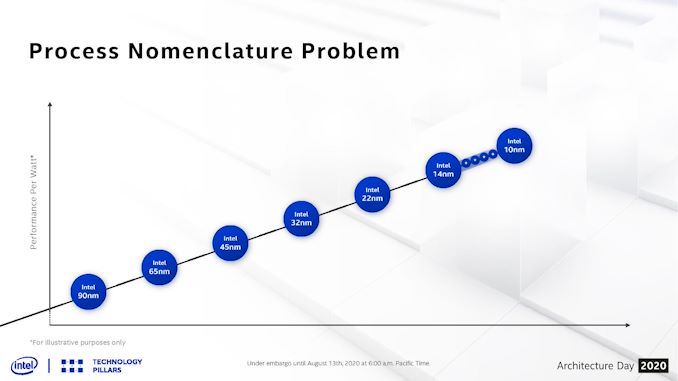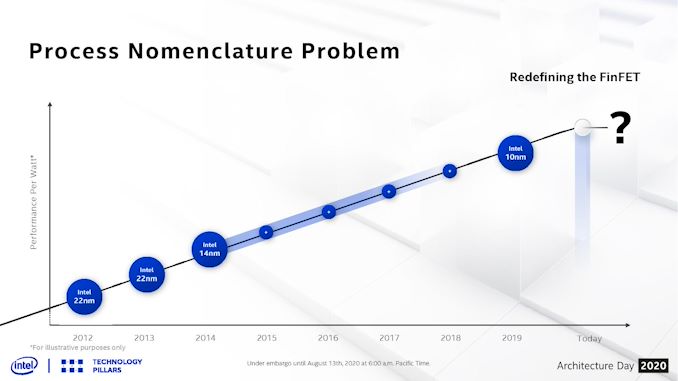What Products Use Intel 10nm? SuperFin and 10++ Demystified
by Dr. Ian Cutress on September 25, 2020 9:00 AM EST_678x452.jpg)
For our audience that regularly keeps track of Intel’s product portfolio, it would be hard to miss that the naming strategy of Intel’s process node technologies is a bit of a mess. To some, those words are themselves an understatement, as Intel has shifted its naming strategy 2-3 times since the launch of Intel’s first 10nm products. Not only that, even Intel’s various departments internally have a hard time keeping track of ‘what is this manufacturing process being called today’ when the press like AnandTech ask for details on the latest upcoming products.
Knowing this, and knowing what issues Intel has been having, I wanted to demystify Intel’s manufacturing process naming scheme such that users and engineers alike, even if they are inside Intel, can understand what is what but also importantly why. The why is the crucial factor.
If you're looking for a handy decoder ring for Intel's 10nm Products, it's here in page 3.
Why Do We Have Multiple Versions of a Process?
With Intel’s 14nm, we were invited to 14nm, 14+, 14++, 14+++, and if you believe Intel’s own slides, there were variants that went beyond this ++++ naming scheme. Each one of those additional + points on the end of the name signified a change in the process technology – usually to assist for increasing performance or efficiency.
Each one of these + points is an update to the BKM, or Best Known Methods.
While an engineer can draw an electrical layouts for a part of a processor, such as an addition circuit, actually applying that design to a silicon floorplan for manufacturing is a different skill altogether. Transistor libraries are designed to take advantage of a given process, and when a floorplan is optimized for a process, it can then be pasted and repeated as necessary – on top of this, simulation on thermals, power, and current density are applied to ensure that there are no hotspots or that critical paths inside the design have as few bottlenecks as possible.
When an update to the BKM occurs, two things can happen. Normally we see the update on the level of the transistor library that is changed – if the distance between two fins on a transistor increases for example, the transistor library and the macros may be made bigger, and then the floorplan might be redesigned to take account for this. As for any process node design, there are 100 different controls, and improving one might make three other controls worse, so it is a fine balancing act. Not only this, but the BKM has to be validated at the manufacturing level. The BKM update could apply to the metal stack as well, which in of itself can adjust the performance.
In the long long past, BKM updates were never advertised externally. If Intel or TSMC or another foundry discovered a way to improve the performance, or decrease the voltage, or improve the yield, the update was silently rolled into the design and nothing much was made of it. Sometimes processors would be listed as ‘1.0 volts to 1.35 volts’, and it would just be a roll of the dice if a user obtained one of the lower voltage models.
However, as time between different process node updates has elongated, these BKM updates have started to be identified and effectively monetized by the semiconductor companies. An update to a process that improves the voltage by 50 millivolts and increases frequency by 200 MHz immediately becomes a productizable event, and products built on these updates can be offered for more money over the usual. Or, depending on the rate of updates, the whole next generation of products could be built on the update.
So we never saw BKM updates officially announced at Intel’s 45nm, 32nm, or 22nm process nodes. These updates were fast enough that the productization of any update didn’t warrant a full round of marketing. With 14nm, that changed.
Intel had discussed its roadmap beyond 14nm since its 2010 Investor Meeting. It predicted that the company would be on 14nm by 2013, 10nm by 2015, and 7nm by 2017. As we now know, 14nm was two years late, and 10nm was 2-4 years late. Because of the introduction of 10nm being delayed, Intel decided to productize its 14nm BKM updates, and signified those with + points.
Intel’s current official line is that there have been four updates to 14nm, creating five ‘generations’.
More Plus Means More Meme
Because of all the + points, Intel’s marketing sometimes getting it wrong, and perhaps a little bit of ‘++’ in most programming languages meaning ‘+1’, the whole concept of adding + to the process node has become a meme – a meme at Intel’s expense, purely on the basis of its failure to deliver 10nm before the 14++++ naming scheme got out of hand.














143 Comments
View All Comments
RobJoy - Friday, October 23, 2020 - link
OS developers as well as all other major software firms are slowly moving away from x86 altogether.We are witnessing a beginning to the slow death of x86.
It may take 5 or 10 years, but it is starting now.
adt6247 - Friday, September 25, 2020 - link
Couldn't disagree more. I want Intel to be competitive to AMD. I think part of the problem with the last decade is that Intel was complacent, because AMD was no threat until Ryzen. I don't want AMD to get complacent either.shabby - Friday, September 25, 2020 - link
Amd isn't run by a pencil pusher.Drumsticks - Friday, September 25, 2020 - link
Krzanich was an engineer with decades of experience, wasn't he? Jen Hsen has a technical background, and Nvidia's advances are still far better than what Intel did over a similar timeframe, but it certainly appears true that AMD is managing to put out their most competitive salvo in years with Nvidia in years. Turing was a stumble, and Ampere is great, but RDNA2 looks to be making up a lot of lost ground.I don't think having a tech background is the only thing that determines success, although it often seems like it won't hurt. I agree with most other posters - having two competitors will definitely be better than having one.
Hifihedgehog - Friday, September 25, 2020 - link
"Krzanich was an engineer with decades of experience, wasn't he?"He was an undergraduate chemistry major that started as a process engineer at Intel. To my knowledge, electrical engineering was never in his wheelhouse and he followed a more conventional managerial path in rising in the ranks. He is most certainly not at the intellectual level of whizzes like Lisa Su whose corpus of doctoral texts on electrical engineering are par excellence.
michael2k - Friday, September 25, 2020 - link
I'm not sure what you mean by Turing was a stumble? You mean because it didn't achieve the same level of performance gain as Pascal? The problem is that these designs don't exist in a vacuum. NVIDIA chose to focus on RTX and ML that generation, which is paying off because it's now a second generation technology while AMD is only now going to offer it as a first generation technology next year, which means NVIDIA might be on their third generation when AMD is still on their first.AMDSuperFan - Friday, September 25, 2020 - link
Don't forget Big Navi which will soundly beat the Nvidia Voodoo2 technology.JKflipflop98 - Friday, September 25, 2020 - link
Big Navi is going to sit in a corner and beg NV for a few scaps of market share. Just like every other video card AMD has ever made.Spunjji - Friday, September 25, 2020 - link
@michael2k - all signs still indicate that Big Navi should be here this year.Luminar - Saturday, September 26, 2020 - link
Big Navi will be here this year you say? Perfect. Another calamity in 2020!